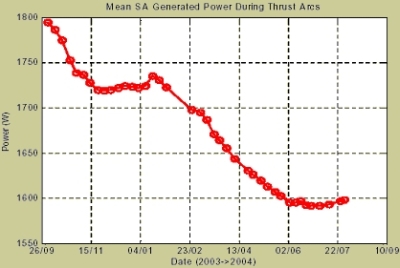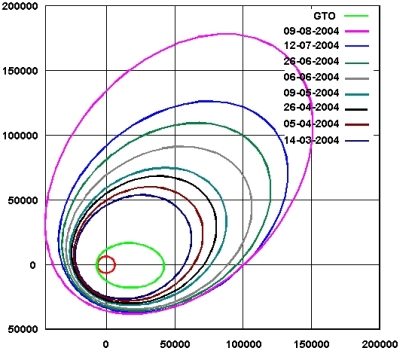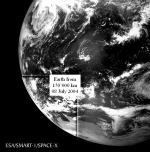No. 27 - Making Progress Towards the Moon
Up to 10 August, and the 262nd engine pulse, the SMART-1 electric propulsion system has cumulated a total ON time of nearly 3000 hr, consumed about 47 kg of Xenon and imparted to the spacecraft a velocity increment of about 2213 ms-1.
Power
The power system performance are good and as expected the power generated by the solar arrays continues to rise since aphelion (4 July), as shown in the graph below which shows the evolution of the power produced by the solar panel since launch.
 |
|
Power Output from Solar Panels since Launch |
Systems Update
This period has been characterised by a change in the thermal environment caused by the EP thrusting strategy and the elongation of the orbit. Some units, like batteries and the star tracker optical heads, have registered high temperatures. This has caused a minor incident resulting in a reconfiguration to the redundant unit. The degradation of the transmitter A has slowed down considerably in the last two months, after a steady degradation for about three months. The cause of the degradation is still unknown and under investigation.
Two Opto-coupler Single Event Upsets (resulting in an engine flame-out) occurred on 20 and 21 July. Some correlation could be identified with recent increased solar activity, although the upsets occurred about 1.5 days in advance. In both cases, the on-board software automatically restarted the engine.
On 30 July, there were fluctuations in the Xenon supply thermothrottle current and several other thruster parameters. The cause of this behaviour is the closed loop control switching between two discrete operating conditions. This event was first reported in status report 21.
In order to avoid such fluctuations, the EP nominal power setting was reduced from 1358.1W to 1285.3W. As a result, the subsequent thrust pattern has been re-optimised.
Science Update
AMIE
The first lunar resonance approach is planned on 19 August around 17:25 UT, when the spacecraft will be at 230 000 km geo apocentre and 197 492 km from the Moon. Some payload operations are planned including possible views of part of the far side of the Moon by AMIE (a European first).
The next lunar resonances are scheduled for 13 September and 13 October. Lunar capture is planned for 15 November, and after EP spiralling down to polar lunar orbit with 300 km perilune and 3000 km apolune, we should start lunar commissioning and lunar science operations in mid-January 2005.
The latest status and first results from SMART-1 were presented during the Lunar session and a dedicated press conference organised at COSPAR Paris on 22-23 July. In particular images obtained from the AMIE camera from Middle East and Mediterranean, as well as of Australia and Pacific were presented. The world space agencies recognised the precursor role of SMART-1 in a fleet of lunar orbiters and landers planned for the next 10 years.
Orbital/Trajectory information
The osculating orbital elements are periodically computed by the ESOC specialists. These elements define the so-called "osculating orbit" which would be travelled by the spacecraft if at that instant all perturbations, including EP thrust, would cease. So it is an image of the situation at that epoch. In reality the path travelled by the spacecraft is a continuous spiral leading from one orbit to another. The most recent osculating elements are as follows:
|
EPOCH (UTC) 2004/08/09 08:38:45.9 Elements WRT Earth (J2000) |
|
| Pericentre Distance (km) |
32 428.761276 |
| Apocentre Distance (km) |
208 705.391870 |
| Semi Major Axis (km) |
120 567.076573 |
| Eccentricity |
0.731031 |
| Inclination (deg) |
6.910780 |
| Asc. Node (deg) |
116.667106 |
| Arg. of Pericentre (deg) |
232.868912 |
| True Anomaly (deg) |
180.073607 |
| Osc. Orbital Period (h) |
115.731500 |
In this diagram the osculating orbits at launch (GTO) and at different times are plotted. The large effects that the operations of the electric propulsion now have on the orbit expansion is clearly visible. Especially the height of the apogee has dramatically increased and now exceeds one third of the Earth Moon distance.
 |
|
SMART-1 osculating orbit up to 10 August |
Since the start of the mission, the electric propulsion system has changed the orbital parameters as follows:
- The semi-major axis from 24 626 km to 120 567 km
- The perigee altitude from 656 km to 26 050 km
- The apogee altitude from 35 880 km to 200 000 km
- The orbital period from 10 hours 41 minutes to 4 days 19 hours
Contact Points
Giuseppe Racca
SMART-1 Project Manager
ESA/ESTEC - SCI-PD
Keplerlaan 1- 2200 AG Noordwijk, The Netherlands
E-mail: Giuseppe.Racca esa.int
esa.int
Bernard H. Foing
SMART-1 Project Scientist
ESA/ESTEC - SCI-SR
Keplerlaan 1- 2200 AG Noordwijk, The Netherlands
E-mail: Bernard.Foing esa.int
esa.int



